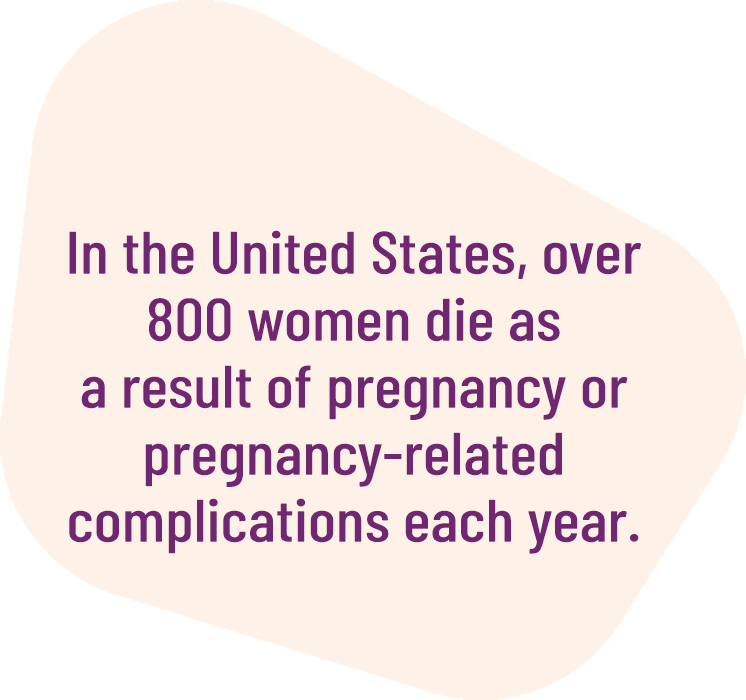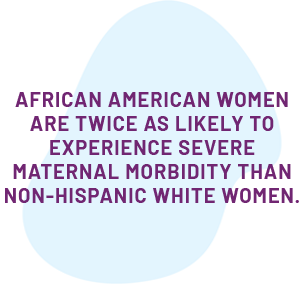According to the March of Dimes, 6.9 million women of childbearing age are living with no or limited access to care.
A Rising Trend
While rates of pregnancy-related deaths have been falling globally for the last 25 years, the rate has more than doubled in the United States. In addition to a rising number of deaths, Americans are experiencing an increase in severe health complications as a result of pregnancy and childbirth. For women of color, the statistics are even more concerning and demand a change in how we approach maternal health as a nation.
Definitions
A pregnancy-related death is defined as the death of a woman during pregnancy or within one year of the end of pregnancy from a pregnancy complication, a chain of events initiated by pregnancy, or the aggravation of an unrelated condition by the physiologic effects of pregnancy.
Severe maternal morbidity (SMM) includes unexpected outcomes of labor and delivery that result in significant short- or long-term consequences to a woman’s health, such as blood transfusions, hysterectomy, ventilation, or temporary tracheostomy.

Statistics
In the United States, over 800 women die as a result of pregnancy or pregnancy-related complications each year.
Between 1987 and 2021, deaths during pregnancy and up to a year after delivery more than doubled, rising from 7.2 per 100,000 live births to 32.9 per 100,000 live births.
A recent CDC study of maternal deaths across 36 states concluded that 84.2% of maternal deaths were preventable.
For the period of 2017 to 2019:
- 21.6% of deaths occurred during pregnancy
- 13.2% of deaths occurred on day of delivery
- 12.0% of deaths occurred 1-6 days postpartum
- 23.3% of deaths occurred 7-42 days postpartum
- 30.0% of deaths occurred 43-365 days postpartum

Differences in Outcomes
Unfortunately, many discussions of the maternal health crisis exclude evidenced-based differences in outcomes based on race and ethnicity. Black women are twice as likely to experience severe maternal morbidity than non-Hispanic White women. Although other women of color have elevated risks—notably Native American, Alaska Native (AIAN), and some Latina women—the difference in outcomes between African American and non-Hispanic White women are stark.
More Research Needed
There is little information about how women of color are affected differently by the timing in onset and manifestation of SMM. A recent study published in the Journal of Racial and Ethnic Health Disparities found that Black women experience the highest proportion of SMM during the antepartum period. From the study’s authors:
“addressing racial disparities in maternal morbidity and mortality requires national policies and initiatives tailored to black women that address the specific types and timings of life-threatening obstetric complications.”

AIM CCI’s Approach
One of AIM CCI’s primary goals is continually addressing social and environmental factors that impact maternal health outcomes through our non-hospital focused safety bundles. We strive for a health care system where racial identity holds no influence on maternal health outcomes.
Follow along with the progress of our pilot sites here and read the latest updates from our team here.
Sources
- March of Dimes 2022 Report Card
- CDC – Reproductive Health
- Taylor, J., Novoa, C., Hamm, K., and Phadke, S. (May 2, 2019). Eliminating Racial Disparities in Maternal and Infant Health: A Comprehensive Policy Blueprint. Center for American Progress. https://www.americanprogress.org/issues/women/reports/2019/05/02/469186/eliminating-racial-disparitiesmaternal-infant-mortality/
- Liese KL1, Mogos M2, Abboud S2, Decocker K2, Koch AR3, Geller SE4 (2019) Racial and Ethnic Disparities in Severe Maternal Morbidity in the United States. J Racial Ethn Health Disparities. 2019 Mar 15. doi:10.1007/s40615-019-00577-w. [Epub ahead of print]
- Equity in the Center. Awake to Work to Work: Building a Race Equity Culture.
- Petersen, Emily E et al. “Vital Signs: Pregnancy-Related Deaths, United States, 2011-2015, and Strategies for Prevention, 13 States, 2013-2017.” MMWR. Morbidity and mortality weekly report vol. 68,18 423-429. 10 May. 2019, doi:10.15585/mmwr.mm6818e1
- Hoyert DL. Maternal mortality rates in the United States, 2020. NCHS Health E-Stats. 2022. DOI: https://dx.doi.org/10.15620/cdc:113967external icon.



